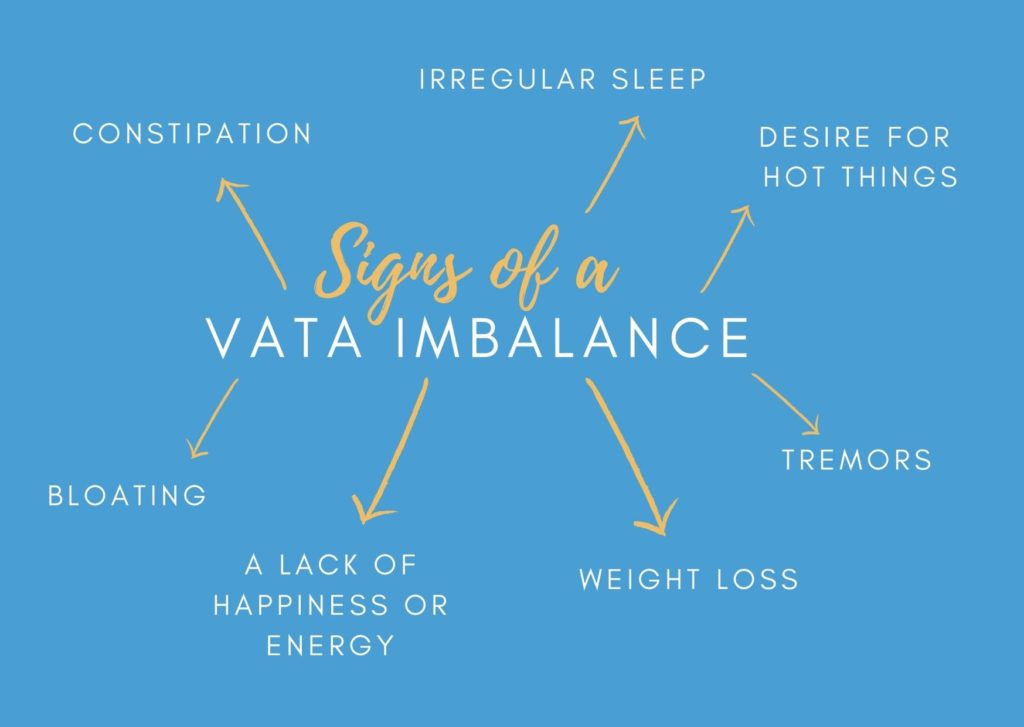What are the signs of a Vata Imbalance? Keep reading to find out…
According to Ayurveda, all energy in the natural world is composed of the five basic elements – air, fire, water, earth, and ether. These elements ignite themselves within humans as the three doshas; Vata, Kapha and Pitta, respectively. As all people have a unique makeup according to their doshas, it’s important to balance the body for optimal energy and functionality.
If one dosha is out of balance, then an individual may notice some unpleasant side-effects. The vata dosha is primarily active in the abdominal cavity (pelvic, colon, nervous system), and is responsible for movements of the body and mind as well as the removal of waste and motor regulation. As the energy responsible for our agni (or digestion), a vata imbalance should always be addressed.
It’s important to note that whilst many of vata’s qualities can be unpleasant, they are not necessarily inherent imbalances. For example, though vata constitutions can experience dryness and interrupted sleep, these qualities do not necessarily allude to an imbalance under Ayurvedic guidelines.
Before we delve into the all-important question: “what are the signs of a vata imbalance”, it’s crucial to recognise that whilst vata constitutions are more prone to this imbalance, it is possible for all doshas to experience a vata imbalance. In fact, as the vata dosha corresponds to space and air, it is inherently unstable. This means that at some point, nearly everyone will need to balance vata!
Signs of a vata imbalance
The easiest way to figure out if you have a vata imbalance… is to take a read through the list below. These are the main ways to understand if you have a vata imbalance, and the main signs of a vata imbalance.
- Weight Loss – when vata increases, people can experience unexpected weight loss
- Desire for hot things- someone with a vata imbalance may find they have increased cravings for hot food and drink
- Tremors – as movement is a vata activity, increased movement of the body can be a sign of a vata imbalance
- Bloating – fullness or increased bloating can be a sign of a vata imbalance, as vata is composed of air and ether. Therefore, increased vata can cause gas and bloating in individuals
- Constipation – vata can cause unpleasant constipation if it is too prevalent in the body
- Irregular sleep – as sense organs and the mind are controlled by vata, a vata increase can lead to a loss of sleep
- Loss of sensation
- Lack of strength in the sense organs or sense organ dysfunction
- A lack of happiness, energy, or general enthusiasm
- Forgetfulness or brain fog
- Poor mental health – we may feel ourselves more fearful or worried than usual
- Dry skin

Why do I have a vata imbalance?
You may wonder why you’re displaying signs of a vata imbalance. Often, when we are stressed, we are experiencing a vata derangement (this is more common in those with greater levels of vata in their prakriri).
Whether it’s due to our environment, the climate, lifestyle changes or other factors, any stress on the sympathetic nervous system can cause cortisol to flood the body and create that well-known “fight or flight” response. Therefore, it is no surprise that common vata symptoms such as fear, agitation and intestinal troubles arise from an imbalance.

What can I do about the signs of a vata imbalance?
As balance is key to Ayurveda, you’ll want to bring harmony back to the body as soon as possible.
- Often, seasonal changes can cause a vata imbalance, so be sure to wear appropriate clothing for the season
- Perform a daily self-massage using warmer, heavier oils like sesame
- Stick with light exercise and try not to aggravate your already low energy levels. Stick to light exercise such as yoga and walking if you feel the urge to move
- Be sure to eat in a way that will restore balance to the digestive system
- Favour warmer aromas such as cinnamon, vanilla, lavender, and citrus

As a vata imbalance often stems from stress, it’s crucial to take time to meditate and realign. Though reducing stress is not always easy, it is crucial to reduce the signs of a vata imbalance in the body as soon as you can.
If left unchecked, a vata imbalance may be more difficult to rectify.
So, be sure not to ignore the signs of a vata imbalance and follow the Ayurvedic steps to restore balance and harmony to both the body and mind.





